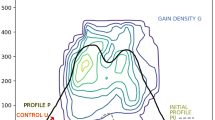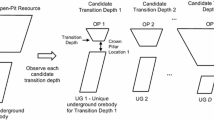Abstract
This paper proposes a new mathematical framework for the open pit mine planning problem, based on continuous functional analysis. The main challenge for engineers is to determine a sequence of nested profiles maximizing the net present value of the mining operation. The traditional models for this problem have been constructed by using binary decision variables, giving rise to large-scale combinatorial and Mixed Integer Programming problems. Instead, we use a continuous approach which allows for a refined imposition of slope constraints associated with geotechnical stability. The framework introduced here is posed in a suitable functional space, essentially the real-valued functions that are Lipschitz continuous on a given two dimensional bounded region. We derive existence results and investigate qualitative properties of the solutions.
Similar content being viewed by others
References
Bazaraa M, Shetty C, Goode J, Nashed M (1976) Nonlinear programming without differentiability in Banach spaces: necessary and sufficient constraint qualification. Appl Anal 5: 165–173
Boland N, Fricke C, Froyland G (2006) A strengthened formulation for the open pit mine production scheduled problem. Preprint, University of Melbourne, Parkville, VIC 3010, Australia
Borwein J, Goebel R (2003) Notions of relative interior in Banach spaces. J Math Sci 115: 2542–2553
Borwein J, Lewis A (1992) Partially finite convex programming, Part I: quasi relative interiors and duality theory. Math Progr 57: 15–48
Boyd S, Vandenberghe L (2004) Convex optimization. Cambridge University Press, Cambridge
Cacetta L, Hill SP (2003) An application of branch and cut to open pit mine scheduling. J Glob Optim 27: 349–365
Cacetta L (2007) Application of optimisation techniques in open-pit mining. In: Weintraub A et al (ed) Handbook of operations research in natural resources. Springer, New York
Daniele P, Giuffrè S, Idone G, Maugeri A (1994) Infinite dimensional duality and applications. Math Ann 339:221–239 (2007)
Denby B, Schofield D, Open pit design and scheduling by use of genetic algorithms. Trans Inst Min Met (Sec. A: Min. Industry) 103:A2–A26
Evans L (1998) Partial differential equations. Graduate Studies in Mathematics, vol 19. American Mathematical Society, Providence
Ferland J, Amaya J, Djuimo MS (2007) Particle swarm procedure for the capacitated open pit mining problem. In: Autonomous Robot and Agents. Studies in Computational Intelligence, Book Series. Springer, Berlin
Guzmán JI (2008) Ultimate Pit Limit determination: a new formulation for an old (and poorly specified) problem. Communication in the Workshop on Operations Research in Mining, December 10–12, Viña del Mar, Chile
Hochbaum D, Chen A (2000) Performance analysis and best implementation of old and new algorithms for open-pit mining problem. Oper Res 48: 894–914
Hustrulid W, Kuchta M (2006) Open pit mine planning and design, vol 1: Fundamentals. Taylor & Francis, London
Johnson TB, Sharp WR (1971) A Three-dimensional dynamic programming method for optimal ultimate open pit design. Report of Investigation 7553, U.S. Bureau of Mines
Lerchs H, Grossman IF (1965) Optimum design of open pit mines. Trans CIM 58: 47–54
Matheron G (1975) Parametrage de contours optimaux, Note Geostat. No. 128. Centre de Geostatistique, Fontainebleau
McCormick ST (2006) Submodular function minimization, Chap. 7. In: Aardal K, Nemhauser G, Weismantel R (eds) The handbook on discrete optimization. Elsevier, Amsterdam, pp 321–391
Morales N (2002) Modelos Matemáticos para planificación minera. Engineering Thesis, Universidad de Chile, Santiago, Chile
Preiss D, Zajíček L (2001) Directional derivatives of Lipschitz functions. Isr J Math 125: 1–27
Topkis DM (1978) Minimizing a submodular function on a lattice. Oper Res 26: 305–321
Wilke FL, Wright EA (1984) Determining the optimal ultimate pit design for hard rock open pit mines using dynamic programming. Erzmet 37: 139–144
Author information
Authors and Affiliations
Corresponding author
Rights and permissions
About this article
Cite this article
Alvarez, F., Amaya, J., Griewank, A. et al. A continuous framework for open pit mine planning. Math Meth Oper Res 73, 29–54 (2011). https://doi.org/10.1007/s00186-010-0332-3
Received:
Accepted:
Published:
Issue Date:
DOI: https://doi.org/10.1007/s00186-010-0332-3




